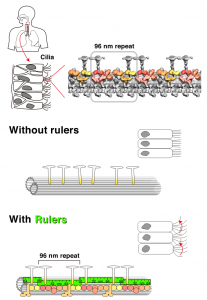A molecular ruler in eukaryotic cells Discovery of a nanometer-scale ruler protein in eukaryotic cells


Upper left: Cilia are present in the human trachea in order to discharge foreign bodies as sputum.
Top right: fine three-dimensional structure of cilia taken by cryo-electron tomography. The 96-nanometer periodic structure is visible.
Bottom: If there is no nano-molecular ruler, a repeating structure is not formed and cilia are immotile. When the molecular ruler is present, dynein motor proteins are aligned in accordance with the ruler’s 96-nanometer period and the cilia are motile.
© 2014 Masahide Kikkawa.
Researchers led by Professor Masahide Kikkawa at the Graduate School of Medicine, the University of Tokyo have discovered that a protein complex, CCDC39/CCDC40, works as a nanometer-sized molecular ruler in the cell.
The nano-molecular ruler was discovered in incredibly thin motile cellular organelles called “cilia”. Cilia are found in many tissues such as the trachea, sperm, oviduct, and brain. Cilia generate fluid flows by beating motions, which are driven by a motor protein called dynein. Dyneins are regularly arranged inside cilia with a 96-nm periodicity.
In this study, Assistant Professors Toshiyuki Oda and Haruaki Yanagisawa in Professor Kikkawa’s lab used cryo-electron tomography, which can visualize cell ultrastructures without staining, and discovered that the FAP59/FAP172 complex works as a 96-nm long “nano-molecular ruler”. The complex arranges dyneins with 96-nm repeat and enables coordinated motion of the motor complex.
Since mutations in this nano-molecular ruler are found among congenital so-called “ciliary diseases,” this research will contribute to research into infertility, respiratory disease, hydrocephalus and other cilia-related diseases. The discovery is also expected to be of relevance to the design of complex nanomachines.
Press release (Japanese)
Paper
Toshiyuki Oda, Haruaki Yanagisawa, Ritsu Kamiya, and Masahide Kikkawa,
“A molecular ruler determines the repeat length in eukaryotic cilia and flagella”,
Science vol.346 issue 6211, doi: 10.1126/science.1260214.
Article link
Links
Division of Structural Biology, Graduate School of Medicine (Japanese)
Department of Cell Biology and Anatomy, Division of Structural Biology, Graduate School of Medicine







